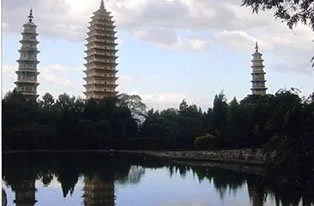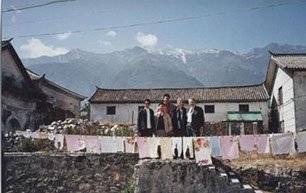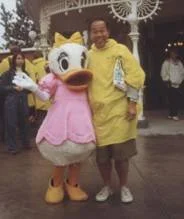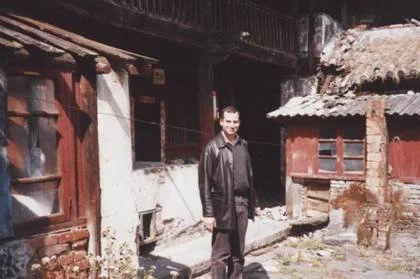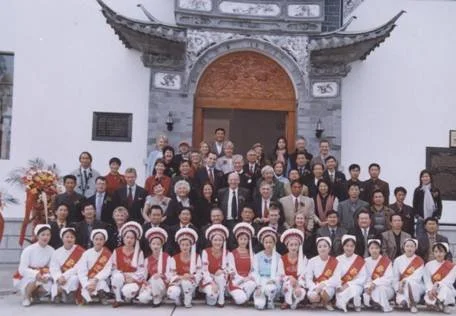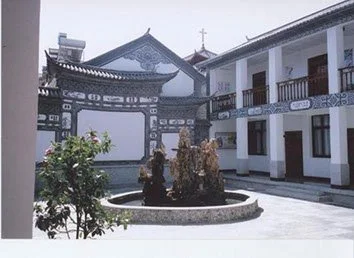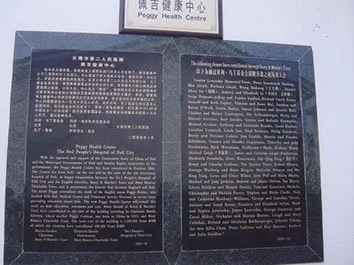Saving Lives in South-West China: The Peggy Health Centre
By Martin Gordon, article excerpted from GB China Centre China Review issue 32 2005
FROM THE ASHES of an old missionary hospital has arisen the first hospital building in China dedicated to Aids education, prevention, treatment and care – the Peggy Health Centre. Inaugurated on 27 October 2004 in Dali, Yunnan, the most Aids-endangered province in China, the building highlights the co-operation between two English charities and the hospital and municipality of Dali. It also restores medical links between the United Kingdom and Dali that stretch back through triumph and tragedy over more than a hundred years.
Introduction
Nestling between Lake Erhai and the Cangshan mountain, with its wild azaleas and camellias behind, Dali has in recent years become one of the most popular tourist and backpacker centres in southwest China. It was the capital of the Nanzhao Kingdom which, in its heyday around 750 to 900 AD, twice repelled the armies of the Tang, captured Chengdu and Hanoi and ruled the whole of Yunnan. After 900, the Kingdom of Dali was ruled by the Duan dynasty until it was betrayed into the hands of Kubla Khan in the thirteenth century, and it remained under Chinese control – with occasional rebellions – ever since.
After the brutal suppression of the Moslem Rebellion of 1855 to 1873, Yunnan became open to foreigners and an early target of the China Inland Mission, founded in 1865 by Yorkshireman James Hudson Taylor. The first missionaries dispatched to “Tali-fu” were George W. Clarke and his Swiss wife Fanny, who took up residence in June 1881. Fanny died two years later and her husband bought a plot of land outside the town for her burial, which all subsequent missionaries used to visit. In the early years the missionaries were mainly devoted to treating opium addiction in addition to spreading the Christian message.
The Mission Grows
In 1903 the mission acquired a more serious medical character with the arrival of Dr Walter T Clark. He is recorded in 1905 as treating 2,878 patients in one year, of whom 780 were women. The missionary Ethelwyn Naylor came out to marry Dr Clark in 1908 and they continued until they went on furlough in 1910. The annual report for 1913 reports the “best year in the history of the work of Dali”, with 17 baptisms, a day school for 20 boys, 2500 patients in the dispensary, and 150 men breaking off the habit in the opium refuge. And through the generosity of a friend, the Huston Memorial Chapel was built, commemorating American missionary Mary Huston who came out to China in 1895, and was murdered in 1900 in the Boxer Rebellion whilst nursing opium patients. The missionaries carrying out this exemplary work from 1913 were William Hanna and his wife Roxie. Hanna remained until the anti-foreign agitation of 1927 drove all the foreign missionaries away. Meanwhile the “Talifu Earthquake” of 1925 had destroyed the town, and the chapel lay in ruins.
In the absence of foreign missionaries from 1927, the mission in Dali continued under the Chinese pastor Ting Li-Mei. When the golden jubilee of the Talifu Mission was celebrated in 1931, the chapel appears to have been reconstructed and beautifully decorated. The mission continued to flourish in Chinese hands throughout the thirties, although the medical work appeared to decline.
In 1941 the most formidable and effective of the modern missionaries arrived - Dr Jessie McDonald. After she had withdrawn from Kaifeng in Henan ahead of the Japanese, “Jessie Mac” and her companion Miss Mabel Soltau managed to bring most of the equipment from the hospital in Kaifeng to Shanghai, shift it to Rangoon, and eventually up river and overland to Dali. She established the gospel hospital as a 40-bed facility “to become the medical centre for a million people for whom no other up-to-date medical treatment is available”, and as “the means of meeting the spiritual needs of the community through the preaching of the Gospel”.
After 1949 it took about a year for the Revolution to penetrate to Dali and the work of the hospital continued until the beginning of 1951 when Jessie Mac and all her foreign colleagues were forced out. “We never expected to leave Dali” Dorothy Toop told me recently in Scotland. “We brought our furniture and curtains from Edinburgh – we thought the Dali hospital was to be our life’s work – but it was not to be”. Dorothy and her husband William, both born to missionary families in China, had arrived in Dali in 1949. Their second son Ken, now an obstetrician in Middlesbrough, was born at the Gospel Hospital that year. But by March 1951 they were bumping out of town in a horse and cart. Others were less fortunate. One of their neighbour missionaries, who loved and cared for a colony of lepers, saw all her patients taken out and shot.
Rebuilding the Hospital
Site of hospital after the fire and before rebuilding
The Gospel Hospital was the precursor for the more modern No 2 People’s Hospital of Dali City, and the old Gospel Hospital gradually fell into disrepair and was burnt down in March 2002, when some squatters lit a fire in the courtyard. The Peggy Health Centre has been built on this site, with added land to make a larger and earthquake-proof structure, still in the Bai architectural style. The old chapel survived with its bell tower intact right beside our new building.
Barry Chan 1944-1996, to whose memory our Trust is dedicated
I established Barry & Martin’s Trust in 1996 in memory of my late best friend Barry Chan, with the aim of cooperating between England and China in Aids prevention, education, treatment and care. I felt at the time that China would have a major problem with Aids, and that exchanges of doctors and nurses between England and China would help. One of our earliest activities was to sponsor, jointly with the Chinese Academy of Preventive Medicine, a seminar in Beijing attended by many of the leading Chinese practitioners in Aids, and with a group of doctors and nurses from the Chelsea & Westminster Hospital. The only non-Chinese attendees were UNAIDS and Voluntary Service Overseas (VSO).
Lifelong nurse Peggy Barnes, an English grandmother in her sixties, had just been sent by VSO to Dali [see China Review issue 16, Summer 2000]. This “Jessie Mac” for the modern era was attached to the Dali Medical Centre as a general nurse, and immediately became aware that Aids was an escalating problem among the Bai people of Dali, and indeed among most of Yunnan’s minorities.
The Clinic Takes Shape
Peggy was not an Aids nurse but she went on to make Aids work her principal activity in Dali. Barry & Martin’s Trust sent an excellent doctor and nurse from Chelsea & Westminster Hospital to assist in establishing the principles of Aids training there.
There was local opposition related to unwillingness to admit to the problem of Aids and to its transmission through drug use and prostitution. However, several local doctors shared Peggy’s enthusiasm and during her three years in Dali they jointly conducted Aids workshops in all the county capitals of Dali prefecture. The Foreign Office, the British Embassy in Beijing and our Trust combined to fund her third year.
By the time Peggy left Dali, she had imparted sufficient skills, especially to Dr Zhang Jianbo of Dali, for the work to be continued in Chinese hands – both Han and Bai. Happily, Dr Zhang Jianbo, with the help of VSO volunteer Dr Willy Wong, approached Barry & Martin’s Trust for help to continue the Aids work in Dali. Our Trust and Mary Kinross Charitable Trust – MKCT – have been pleased to continue our cooperation ever since.
Our Trustee James Lewisohn in the old hospital courtyard before the fire
During one of our visits to Dali, fellow Trustee James Lewisohn and I, plus Elizabeth Shields of MKCT, were shown the old Gospel Hospital, no longer in use but reflecting the old charm of Bai courtyard architecture. The dream was born: to rebuild the old hospital and offer it to Dali as an Aids centre run by Zhang Jianbo. Soon after we learned about the fire and determined to work with the local authorities and find the money to rebuild.
Finance was not our only problem. Aids remains a delicate subject in China. Several efforts in recent years to create Aids hospitals in various parts of China have all been defeated by local opposition, including the fear of local people that they would be contaminated. Even in Hong Kong, where greater understanding might have been expected. But this is by no means only a Chinese problem: the London Lighthouse was vigorously opposed by the residents of Notting Hill – until Princess Diana started walking through the door
Working in Partnership
Opening ceremony of the new building, Peggy Health Centre, October 2004
In moving forward in Dali, we wanted to be sensitive to local feelings and operate in close cooperation with the municipal and higher authorities. As a matter of principle, we wanted the local hospital to contribute at least 50/50 to the cost. We were helped by our friends in Beijing and our contacts with the provincial health authorities in Kunming, who were keen to create their own Aids hospital at a provincial level.
Aiding our cause has been the revolution in Chinese policy towards public health since the outbreak of SARS in early 2003. The crisis stimulated the government to tackle other health problems including Aids, and this occurred politically when Hu Jintao and Wen Jiabao were taking over as President and Prime Minister. Wen’s visit to Beijing Ditan Hospital on 1 December 2003, to shake hands and talk with Aids patients on World Aids Day, had immense symbolic significance in China. He was followed on 1 December 2004 by Hu’s visit to Beijing You’An Hospital.
Peggy Health Centre, No 2 People’s Hospital, Dali , Yunnan
The provincial authorities in Yunnan have consistently supported our plans for Dali. In the context of the new health policies in China, they have specifically declared that our project in Dali comes well up to the standard expected under Beijing’s new directives. We signed an agreement with the No 2 People’s Hospital in Dali in February 2004. Its President, Dr Yang Tongxin, had precious recollections of the old Gospel Hospital – the only hospital in town back in the 1950s. The building was completed in advance of our planned 27 October reopening ceremony.
Plaque outside Peggy Health Centre, Dali, Yunnan
The new British Consul General in Chongqing, Tim Summers, joined a group of 36 supporters and friends of Barry & Martin’s Trust. This strongly demonstrated to the Dali officials the powerful foreign support for and the international visibility of the Peggy Health Centre. The Chinese characters for Peggy are propitious. The building has attracted much attention at the national level, and we hope to recreate the Peggy Health Centre as a model clinic in other parts of China. There is every sign that it will bring distinction to Dali and set an example of excellence in Aids care that others around China will follow.
